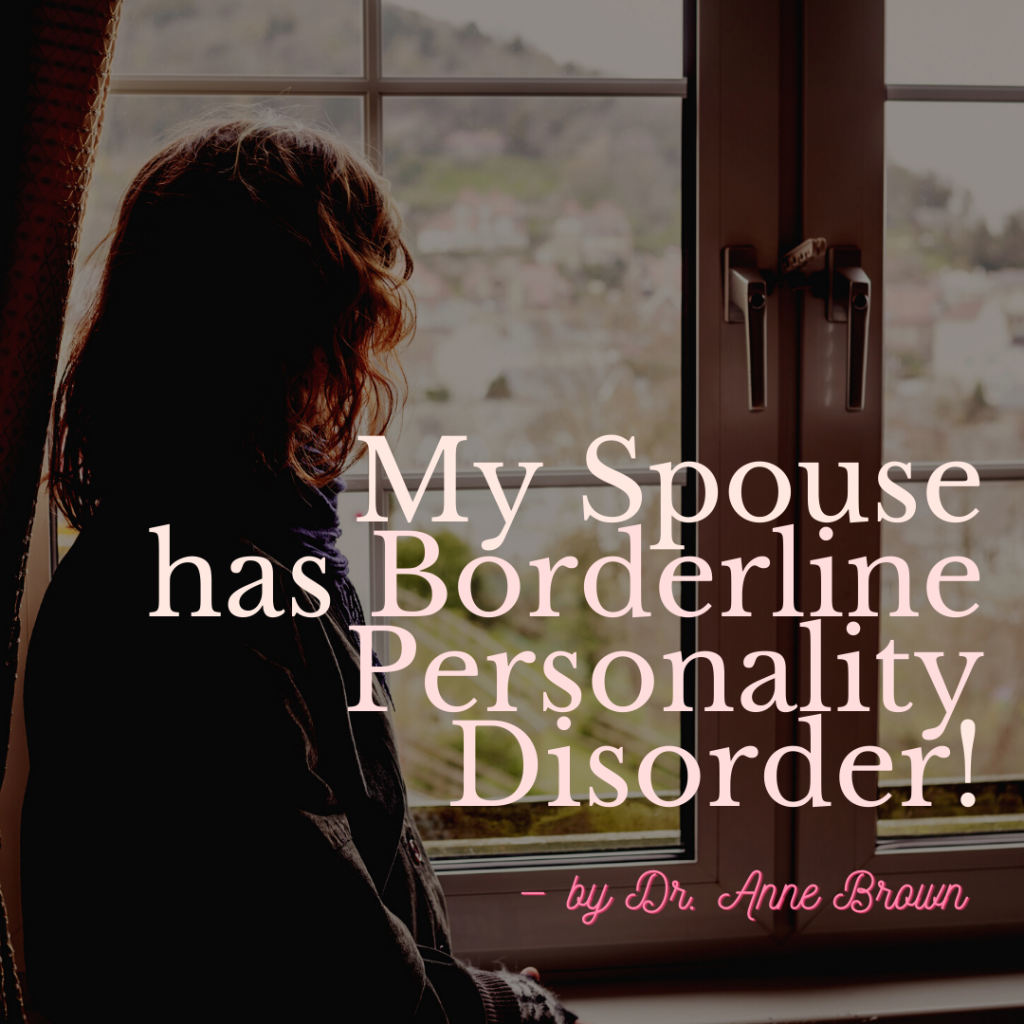
When your spouse has a Borderline Personality Disorder (BP), whether it’s a sudden realization or a long-known fact, it can be challenging. Those in relationships with BP individuals may be subject to unique forms of manipulation or toxicity. Recognizing these habits of BP is the first step to liberation. I will address different toxic tools here so you can pick from both articles the toxicity that you are experiencing. You may not have all of them and I may not address all of the ones you are experiencing. I also am addressing emotionally leaving the damage of the BP. To leave the BP physically is a personal decision and might be best made after leaving emotionally.
It’s also important to note the difference between those with borderline personality disorder and narcissistic personality disorder. While the two conditions manifest similarly, especially in relationships, there are differences in the tactics the NP and BP individuals use to manipulate their loved ones. This article will deal with leaving and recovery from BP individuals, not leaving and recovering from the NP.
One important distinction I’d like to address before we tackle a few of the toxic tools of BP is the difference between violence and anger. If you have a partner who is capable of violence, you need to do whatever is necessary to keep you safe. If you have a partner who is volatile and can demonstrate intense anger, but no violence, do not be intimidated by the anger. As you start to get healthy, be prepared for BP to get intensely angry. Do not stop getting healthy because BP has intense anger. This will take rigor and you can do it!
The Toxic Tools of a Borderline Spouse
Instill Anxiety
Unfortunately, the way the BP views life produces intense anxiety for the BP. Anxiety about someone getting too close or too far away. Anxiety about feeling self-hatred, rejected, lost, alone, unloved, invisible, and on and on. In a normal situation, any adult feeling this way would seek out help from a professional. BP seeks out people close to them to carry this anxiety and emotional pain. The BP wants to control every situation in order to have others feel these negative feelings for him/her.
Unfortunately, the caretaker is a wonderful victim. No adult is responsible for another adult’s pain. It is not our job to carry anyone’s emotional pain. We are all responsible for healing our own wounds. The caretaker needs to understand more than likely he/she is enabling this dysfunctional behavior and that the BP is not getting better. If there are children involved, you are teaching the children to enable and carry the anxiety and pain of BP. Please for the family’s sake get professional help from someone trained in helping victims of BP.
Negativity Projection
The simple definition of projection is “I will see in you the negativity that is really true about me.” The BP has such intense emotions, both positive and negative, and doesn’t want to experience the negative so will look for a “container” to hold these emotions. The spouse who is trying to take care of the BP will usually unconsciously agree to become this “container”. If you hear yourself saying “but I really am a good husband/wife, I do love you, I haven’t been unfaithful” then you have taken on these negative comments which are really the way the BP feels about the BP.
Most of us have these vulnerable places where we question ourselves or make ourselves wrong to keep the peace. The BP is masterful at finding and exploiting these places. (A healthy partner would help you heal these places.) Understanding how damaging Projection is, observing with rigor when it is happening to you, becoming emotionally strong enough to say to yourself: “this is not at all about me”, and having a tool to give the BP a response that is healthy and appropriate for your situation are all things the caretaker needs to learn to emotionally leave.
Projection Tactics
Years ago, I worked in a place where my supervisor (we were not on the equal ground) was masterful at projecting. I had to learn fast how to counter this behavior. Fortunately, I had a mentor who helped me. One day I went to supervision and out of the blue, he accused me of being lazy about doing the consults in the hospital. I covered two days of consults, another clinician covered two days and my supervisor covered one day. The time he accused Me of being lazy, he, in fact, had asked me to cover his last three days.
I had never asked him to cover my days. I quietly responded “Wow tell me what makes you say that. What I remember is you asked me for the last three Fridays to cover for you. I have never asked you to cover for me.” He said, “Hmm I guess that is right” and moved on to another subject. He used this tactic on all of his supervisees and continued to use it on me. I always countered with evidence that seemed to work with him.
“Giving evidence is one tool for projection but not the only one and can’t be used with violent people.“
Dr. Anne Brown
Splitting the World Into Black and White
A simple definition of splitting is seeing the world, people, events, and feelings as all good or bad. You as the caretaking spouse can be all good one minute and all bad moments later in the eyes of the BP. Since BP has the ability to rewrite history, ignore facts, not remember or acknowledge, it is difficult to use rational thinking here.
BP doesn’t want to feel bad feeling so will put those onto someone else. This someone else can be the spouse, child, close relative, friend, situation, etc. Unfortunately, the family begins to organize around BP’s moods, anxiety, uncomfortable emotions, delusional thinking, and erratic behavior. The family organizes a rule book to keep the BP as stable as possible but of course, thinking they can do that is delusional thinking. Breaking free of this BP rule book and giving the BP back the responsibility of managing his/her own emotions is the beginning of “leaving emotionally.”
Enmeshment
In relationships particularly over time, the couple/we begin to take on a life force of its own. In a healthy couple, we replace you and me. Within us, each individual still has his/her own thoughts, opinions, likes/dislikes, etc. This is not what the BP wants. The BP wants his/her spouse to be a carbon copy of the BP (the BP is not going to be like the partner). The BP will feel better if his/her partner has the same likes/dislikes, thoughts, opinions, ideas etc. Caretakers are capable of having their own identity and are at risk of becoming enmeshed with the BP in order to continually try to stabilize the BP. Thinking you can stabilize the BP is delusional thinking. Ask yourself “has it worked so far?”
Beginning to Heal from a Borderline Spouse
These are just a few of the toxic tools one can be dealing with if your spouse has a borderline personality disorder. In Part 2 we will look at what needs to happen for you to heal from this emotional abuse. (Yes, it is emotional abuse.)
If you allow people to make more withdrawals than deposits in your life, you will be out of balance and in the negative. Know when to close the account.
This article originally appeared at Recovery.org
Connect with Dr. Anne Brown!
Say NO to being used. abused, and exploited! We all need to speak up and advocate for ourselves and others.
Backbone Power audiobook will teach you how to do that. Download your copy today!

You might also want to read:



 Facebook
Facebook LinkedIn
LinkedIn Twitter
Twitter Youtube
Youtube StumbleUpon
StumbleUpon
Leave a Reply